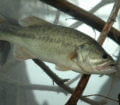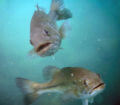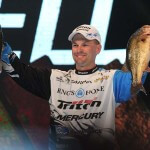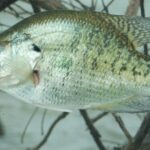John’s Note: Mark Davis of Mount Ida, Arkansas, long-time professional bass fisherman, is one of the quiet giants of professional bass fishing. Davis has won the BASS Angler-of-the-Year title three times and has combined earnings from the BASS and the FLW circuits of almost $2 million. He’s also the only angler to win BASS Angler of the Year and the Bassmaster Classic in the same year (1995). This week, Davis will tell us how he catches bass in really-hot weather, one of his specialties.
 Question: Mark, what’s another technique you’ll use in August and early September in hot weather?
Question: Mark, what’s another technique you’ll use in August and early September in hot weather?
Davis: The shaky-head worm, which is the Strike King (http://www.strikeking.com/) finesse worm, rigged with the Strike King shaky head jig, can be a good way to catch hot-weather bass.
Question: In what type of areas do you like to fish the shaky-head worm?
Davis: The lake will dictate the type of cover you fish around, but I prefer to fish the shaky-head worm around bridge pilings, on humps 10- to 30-feet deep out in the main lake, standing timber, rock piles, creek channels or any type of bottom structure. However, you always need to have a shaky-head worm rigged on a rod in the boat, especially in the summertime, because it’s an excellent back-up bait. For instance, perhaps I’ll find and catch three or four bass off one spot with a Strike King crankbait, and then the bass stop biting. So, I’ll throw a shaky-head worm to the bass, which gives a very-subtle presentation and looks different from the crankbait. The crankbait already has done its job by finding the bass for you. If you put that shaky-head worm back in that same spot where the crankbait has located the bass, you’ll catch bass. The shaky-head worm is always a good back-up bait. Anytime I pinpoint bass in an area, before I leave the bass, I’ll throw a shaky-head worm because I’ll generally catch more bass on the shaky head jig with the finesse worm than with a fast-moving bait, like a crankbait, in the summer.
Question: Mark, what shaky-head jig and worm will you be using?
Davis: My favorite is the Strike King 3/16-ounce round-head Shaky Head jig. I’ll fish two-different worms on the Shaky Head jig. In the springtime, I’ll be using the 5-inch Finesse Worm, but in the summertime, I prefer the 7-inch Finesse Worm. The 7-inch worm has a bigger profile than the 5-inch worm does, it floats-up off the bottom, and it has a lot of action when you shake it. When the water temperatures get hot, the bigger 7-inch worm seems to produce better for me than the 5-inch worm.
 Question: What color do you like?
Question: What color do you like?
Davis: My favorite go-to color is green pumpkin, but I also catch bass on watermelon and smoke colors.
Question: What pound-test line will you be fishing?
Davis: I like 8-pound-test Stren (http://www.stren.com) fluorocarbon line.
Question: Take me through the retrieve from the time you cast the worm out until you get it back to the boat.
Davis: When I cast out the shaky-head worm, I leave my bail open and let the worm free-fall. Be sure to watch your line because as soon as that worm hits the water, especially in the summer, you’ll probably get a strike as the worm’s falling. So, if you see that line stop, twitch or jerk before it hits the bottom, close your bail, take-up the slack, and set the hook. Many days you’ll catch bass when the lure’s falling. Once the bait hits the bottom, I’ll take up the slack in my line because I want to make sure I can feel the bait. Often after you take the slack out of the line, you want to just lift the worm off the bottom with your rod tip to see if there’s a bass on the worm, since often as soon as the worm hits the bottom, a bass will bite it. So, after you take-up the slack, lift-up on the worm to see if a bass is on it. If there’s not a bass on the worm, start shaking the worm with your line, and then hop the worm about 1 foot. When the bait hits the bottom again, shake your line very subtly once more.
 Question: How high will you hop the worm after you shake it?
Question: How high will you hop the worm after you shake it?
Davis: I’ll hop it about 2-feet up off the bottom and let it fall back. But you have to let the bass tell you what they want. I’ve seen times when the bass wouldn’t take the worm unless I hopped it really high up off the bottom and let it fall back down. Other times the bass have demanded that I more or less drag the worm on the bottom before they’ll take it. There are several-various ways you can fish the shaky-head worm, so try it various ways, and let the bass tell you which way they want it.
To learn more about bass fishing, get John E. Phillips’ Kindle eBooks and print books on bass fishing, “How to Win a Bass Tournament,” “Catch the Most and Biggest Bass in Any Lake: 18 Pro Fishermen’s Best Tactics, “Hot Weather Bass Tactics” and “How to Become A Tournament Bass Fisherman” go to www.amazon.com/author/johnephillips or at www.barnesandnoble.com; or an audiobook on “How to Bass Fish Like a Pro” at http://amzn.to/YpoJvD.










